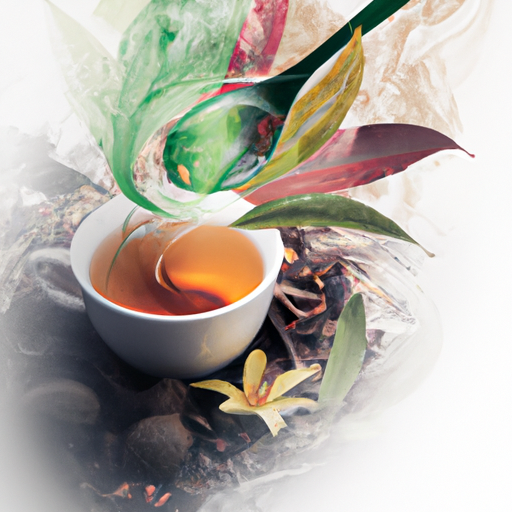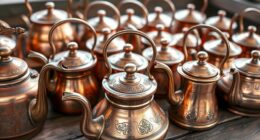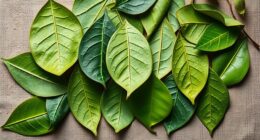Imagine stepping into a world where each sip of tea is a journey of flavors, an exploration of the senses. The art of describing tea flavors is like unraveling a tapestry, where every thread tells a story. It is a delicate dance between the tea cultivar, production technique, and brewing method, weaving together a symphony of taste.
Just as an artist mixes colors on a palette, tea masters craft a palette of flavors, creating a sensory masterpiece.
Within this world, tea is not just a beverage, but an experience. It is a blend of bitter and sweet, a dance between astringency and smoothness. It is the subtle nuances of vegetal and savory, the delicate notes of floral and fruity. It is a symphony of flavors, ranging from nutty and earthy to mineral and spicy.
In this article, we will delve into the complexities of tea flavors, exploring the different categories of tea and the flavor notes they possess. We will uncover the secrets of real teas and herbal infusions, understanding why loose leaf teas offer a more intricate taste.
Join me on this journey as we unlock the mysteries of tea and learn to appreciate its true artistry.
Key Takeaways
- Tea taste is influenced by factors such as tea cultivar, chemical composition, production technique, freshness of tea leaves, and brewing method.
- Tea can be scented or flavored, altering the taste of the original tea leaves.
- Different types of tea have distinct flavor profiles, including vegetal, savory, nutty/toasty, floral, earthy, fruity, sweet, mineral, and spicy notes.
- Brewing techniques, such as using smaller teaware and multiple-steeping, can enhance the extraction of flavors and help explore the nuances of tea taste.
What Determines Tea Taste?
I can determine the taste of tea based on factors like the tea cultivar, chemical composition, production technique, freshness of tea leaves, and brewing method.
These factors play a crucial role in shaping the flavor profile of tea. For instance, different tea cultivars can result in distinct taste profiles, with some teas showcasing vegetal notes while others have a more floral or nutty flavor.
The chemical composition of tea, including the presence of caffeine, catechins, amino acids, and flavonols, also contributes to its taste.
Additionally, the production technique, such as steaming or roasting, can further enhance or alter the tea’s flavor.
Lastly, the brewing method, including water temperature, steeping time, and the amount of tea leaves used, can greatly impact the taste, allowing for a multitude of flavor possibilities.
Different Tea Categories
Categorizing teas based on their unique characteristics allows for a deeper understanding of the diverse range of tastes they offer. There are several tea categories, each with its own distinct flavor profile.
Real teas, including white, yellow, green, oolong, black, and dark teas, have a wide variety of flavors. Green teas have a vegetal taste, while oolong teas offer floral notes of varying intensity. Dark fermented teas and some black teas have earthy undertones. Fruity flavors can be found in certain black teas and darker oolongs, with notes of ripe plum, peach, grape, and passion fruit. Black teas and oolongs also naturally possess sweet flavors, reminiscent of malt, cocoa, chocolate, and honey. Some oolong teas, like Wuyi rock tea, even have mineral notes.
Herbal infusions, on the other hand, have more consistent flavors. Chamomile and mint teas, for example, offer herbaceous and refreshing tastes respectively.
Tea brewing techniques and the aroma and fragrance of the teas also contribute to the overall flavor experience.
Flavor Notes in Tea
Exploring the diverse range of tastes in tea involves understanding the different flavor notes that contribute to its overall profile. When describing tea flavors, it’s essential to explore the aroma profiles that arise from the unique combination of factors like tea cultivar, production technique, and terroir.
The influence of terroir, including factors such as soil, climate, and altitude, can have a significant impact on the flavor notes of tea. For example, green teas can exhibit a vegetal flavor, while oolong teas may offer nutty or toasty notes. Floral flavors can be found in some oolong teas, with varying intensities. Dark fermented teas often have earthy notes, while black teas may have hints of ripe plum or peach.
Understanding the intricate relationship between these flavor notes and the tea’s characteristics is essential in describing the complexities of tea taste.
Frequently Asked Questions
How does the freshness of tea leaves affect the taste of tea?
Freshness impact: Fresh tea leaves retain more volatile compounds, enhancing flavor variations. As leaves age, these compounds degrade, resulting in a dull taste. The freshest leaves yield vibrant, complex flavors that awaken the senses.
What are some common scents used to flavor teas?
Common scent profiles used to flavor teas include bergamot, jasmine, rose, lavender, and vanilla. These scents add unique flavor notes and can enhance the overall taste experience. Additionally, they may have certain health benefits such as relaxation and stress relief.
Can the brewing method affect the taste of tea?
As the saying goes, "The way we brew our tea reveals the true taste within." Brewing techniques, such as water quality and temperature, can greatly impact the flavor profile of tea, enhancing its nuances and bringing out its true essence.
Are there any health benefits associated with the different flavor notes in tea?
There are health benefits associated with the different flavor notes in tea. For example, green tea’s vegetal taste is linked to its high antioxidant content, which can promote heart health and boost the immune system.
Are there any specific tea cultivars known for their unique flavor profiles?
Specific tea cultivars offer a delightful journey through unique flavors. From the vegetal allure of Matcha to the honeyed embrace of Darjeeling, these teas showcase the diverse spectrum of tea flavors.
Conclusion
Describing the flavors of tea is like unraveling a rich tapestry of hidden complexities. It’s an art that requires an understanding of various factors, from the type of tea to the brewing method.
Each sip holds a world of flavors, from the vegetal and savory to the nutty, floral, earthy, and fruity. Exploring the nuances of tea flavors is like embarking on a delicious adventure, where every cup uncovers a new sensation.
So, let’s indulge in the art of tea tasting and discover the delightful symphony of flavors that await us.










